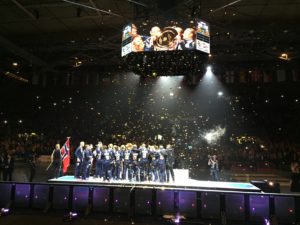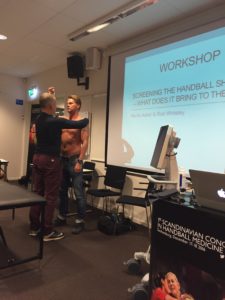Is there a growing interest for handball medicine?
The 1st Scandinavian Congress in Handball Medicine was held during the final weekend of the Women’s Euro 2016, December 17-18th in Gothenburg, Sweden. It was organized by the Medical Committee of the Swedish Handball Federation (SHF) under the patronage of the European Handball Federation (EHF) and the European Society of Sports Traumatology, Knee Surgery and Arthroscopy (ESSKA).

The congress was held at the newly opened Kviberg Park Hotel & Conference. Home of the largest multi-sport arena in Scandinavia with e.g. artificial turf football pitches, handball courts, beach volleyball courts and a unique indoor ski hall.
Inspired by Ted Talks

The main focus of the first day was on shoulder injuries starting off with a symposium on injury prevention. Martin Asker (Sweden) talked about the high prevalence of shoulder problems among elite adolescent players, highlighting the need for prevention strategies at an early age. Grethe Myklebust (Norway) nicely showed that we actually can reduce the amount of shoulder problems in handball players by using a weekly neuromuscular training programme. Merete Møller (Denmark), who just before the congress successfully defended her PhD thesis, highlighted that monitoring load is very important among the youth players (http://bjsm.bmj.com/content/bjsports/51/4/231.full.pdf). Kajsa Johansson (Sweden) then rounded up with a talk for the future by describing the new injury surveillance possibilities through the smartphone app AIM Control.
Rod Whiteley (Qatar) then entered the stage and delivered a keynote lecture with the somewhat provocative title “Throwing out the nonsense in the handballer’s shoulder – what you should and shouldn’t be doing in the clinic”. Rod went through several myths around the shoulder pathologies and highlighted what one should focus a little bit extra on in terms of shoulder assessment in handballers. Thereafter, the former elite player Lior Laver (the UK) outlined the possibilities and limitations with doing arthroscopic surgery in handballers from an evidence-based perspective in his key note lecture.

The main focus was now switched to the knee joint and the morning started early with a symposium on cruciate ligaments injuries. Markus Waldén (Sweden) highlighted a few important takeaways for the sometimes “forgotten” injury to the posterior cruciate ligament (PCL) which is believed to be relatively more frequent in handball compared with many other team sports. Next, Grethe Myklebust took us through her group’s excellent research over 15 years on the epidemiology and prevention of anterior cruciate ligament (ACL) injuries in handball. Tron Krosshaug (Norway) then described what really is going on inside the knee joint when the ACL ruptures.
Romain Seil (Luxembourg), the current chairman of ESSKA, then held a keynote about knee injuries in in the very young and skeletally immature players. He also highlighted how there is life after the handball career – we need to consider not only the injuries, but also the potential long-term problems that could occur later in life such as osteoarthritis.
Free communications
The congress was also open for abstract submissions and the scientific committee accepted eight high-quality abstracts for oral presentations. After deliberation from stiff competition, the award of 500 Euros for the best presentation was given to Sebastian Skejø (Denmark) for his talk on estimating throwing intensity by using small accelerometers.
What can handball learn from other sports?
The closing of the congress consisted of a symposium dedicated to what handball can learn from other sports. Lars Bojsen Michalsik (Denmark) opened up with a talk about the physiological actions and demands in handball. Martin Hägglund (Sweden) underscored how the neuromuscular training programme “Knäkontroll” (Knee control) has been successfully implemented in Swedish football clubs. Fredrik Johansson (Sweden) gave an inspiring talk on training strategies for developing young tennis players and highlighted the importance of training in overhead positions. Markus Waldén argued for improving the overall medical support and arena safety in handball in order to resemble the guidelines in other big team sports. Finally, Lior Laver pointed out the importance of initiating injury surveillance research in high-level handball within the near future such as the studies being carried out in football (http://bjsm.bmj.com/content/47/12/726.long).
Swedish Christmas carols and Norway (again)
A sports medicine congress is never better than what the associated social programme is. A lot of effort was therefore put on this aspect, kicking off with a pre-congress “Get together” followed by the semi-finals (Denmark vs. Netherlands and Norway vs. France) on Friday 16th. The official congress dinner on Saturday 17th started with bubbles and mingling and then the toastmaster Johan Sandberg (Sweden) took the lead by arranging a smartphone-based quiz during the buffet and a hilarious guide on why and how to sing Swedish Christmas carols.
The congress finished off with the fantastic final on Sunday 18th between Norway and the Netherlands in the classic Scandinavium Arena in front of more than 11,000 in the crowd. After some thrilling final seconds of the match, Norway claimed the title with a 30:29 win. Congratulations Norway!
SoMe reach out
With more than 800 individual posts, the congress managed to reach over 400.000 people through Twitter, Instagram and Facebook. If you missed the congress, you can still re-live through Twitter on the account @SCHM2016 and the hashtag #SCHM2016.
*********
Martin Asker is a sports medicine therapist with more than 15 years of experience in handball. He is currently undertaking his PhD at the Karolinska Institutet, Stockholm, Sweden, with the aim to deepen the knowledge in shoulder function and risk factors for shoulder injuries in elite adolescent handball players. He also has a special interest in throwing biomechanics and its relationship to performance and injuries in overhead athletes.
Rod Whiteley, RPT, PhD, is a specialist sports physiotherapist from Australia who has worked extensively at the international level in e.g. rugby league and rugby union as well as in baseball. He has published in a wide range of areas of his clinical interest including throwing injury, muscle injury, and load management. He is currently working at the Aspetar Sports Medicine Hospital, Doha, Qatar.
Markus Waldén, MD, PhD, is an orthopaedic surgeon who is involved in several research projects in football and handball. He is a senior researcher in the Football Research Group, Linköping University, Sweden and his main research interest is knee injuries and return to play issues. He is currently working as a team physician for a men’s professional handball team.